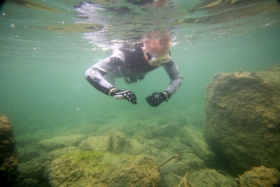Diving on the floating airship hanger
Science 04.08.2014
The members of the Constance Sport Diving Club (TSGK) - German Underwater federation (VDST) - have long been active in efforts to preserve and protect underwater cultural heritage. Therefore, when the club learned of the UNESCO Dive for Peace Day, there was no question that we would take part.
Although the events of the second World War on Lake Constance are relatively well known, most sport divers do not realize that the lake also presents an opportunity to dive in memory of the first World War. Zeppelins are, of course, a common sight over the lake today, but during World War I, these airships also played an important role militarily. In fact, without the demand created by the war, they would probably not exist. The first Zeppelins were built out on the water in a gigantic floating hangar, and it is for this reason that we chose the lake as our destination on Dive for Peace Day.
In particular, we decided to search for the remains of the warehouses that had been located in shallow water. We knew the location of some warehouses from historic documents related to the airship hangars. No one from our group had yet dived in the shallow waters of the lake though, so we didn’t know what to expect once we arrived. In spite of this, we assumed that, in the shallow water, we could first explore the site on snorkel.
At 17:00, seven of our divers departed Konstanz-Stadd aboard the 15m long MV Hörnle; We chose to travel by boat in order to reach a more remote dive site. After a short stop at the EADS dock to pick up two divers from an associated dive club, we continued on or way. We had to proceed very carefully, however, as the remains of numerous piers lay hidden in the shallow water.
We anchored the boat in shallow water, and proceeded out on snorkel to inspect some nearby remains that were marked as “underwater obstacles.” In and among the lush vegetation of the lake, we discovered the remains of some reinforced concrete. The concrete bent in the direction of the shore, and protruded somewhat out of the water. We were especially interested in the end of the remains that lay farthest from the shore. Here, we found what appeared to be the remains of a round guardhouse with a doorway and a small vertical viewing slot. We were surprised to come face to face with something so reminiscent of war.
If one researches the history of the lake, however, this should really come as no surprise. The area saw industrial use since the construction of the airship hangar in 1899 at the latest, and such use only increased afterwards. We were most likely diving at the pier of an old port facility, and it is possible that further remains still lay hidden under the summer vegetation.
Naturally, we now wonder what period the guardhouse dates to, and we plan to search among old pictures of the area in order to solve the mystery.
After a second dive that night, we then returned across the lake. During the journey, everyone on the boat agreed that diving into the recent past is always exciting.
Related pictures & videos
 science
04.08.2014
Diving on the floating airship hanger
science
04.08.2014
Diving on the floating airship hanger



























